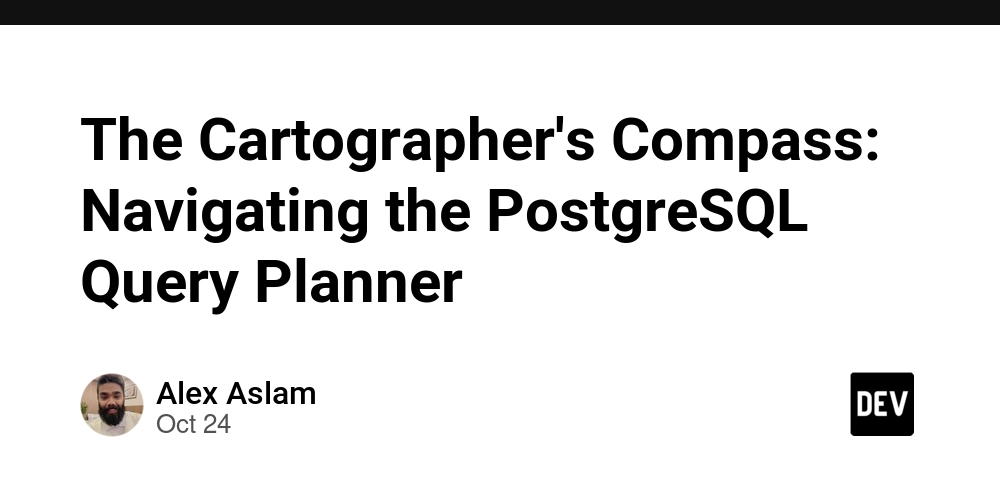The Cartographer’s Compass: Navigating the PostgreSQL Query Planner
There is a moment in every application’s life when the magic fades. The User.limit(10) that once returned in milliseconds now takes seconds. The elegant includes that solved your N+1 queries has become the source of a new, more sinister problem. You look at your EXPLAIN ANALYZE output and see the dreaded words: Seq Scan on users.
You’ve entered the realm of the Query Planner, the most sophisticated and misunderstood part of your system. This isn’t a bug to be fixed; it’s a conversation to be had. You are no longer just a Rails developer; you must become a cartographer, learning to read the maps that PostgreSQL draws for you.
The Philosophy: The Planner as Master Cartographer
Think of your database as a vast, uncharted continent. Your data is the terrain—mountains of users, forests of posts, rivers of transactions. The Query Planner is the master cartographer you consult before a journey.
You ask it: “How do I find all recent orders for a user?”
The Planner doesn’t just give you directions. It considers every possible route. It has a deep understanding of the landscape:
- The Roads (Indexes): Fast, direct paths like BTrees, or specialized paths like GiST or GIN.
- The Terrain (Table Statistics): How many users are there? How many have orders? Is the data clustered or scattered?
- The Cost of Travel (CPU & I/O): Is it cheaper to scan a small index or traverse the entire table?
The EXPLAIN output is the cartographer’s final map. Our job is to learn how to read it, and when we see it leading us through swamps instead of along highways, we must learn how to redraw the map itself.
The Art of the Map: Reading EXPLAIN
Let’s start with a simple query from our Rails app:
# A seemingly innocent scope
User.where(company_id: 123).order(created_at: :desc).limit(10)
The SQL:
SELECT "users".* FROM "users"
WHERE "users"."company_id" = 123
ORDER BY "users"."created_at" DESC
LIMIT 10;
Now, let’s ask the cartographer for the map: EXPLAIN (ANALYZE, BUFFERS)
Limit (cost=0.42..125.64 rows=10 width=145) (actual time=0.128..4.215 rows=10 loops=1)
Buffers: shared hit=1854 read=321
-> Index Scan Backward on users_created_at_idx (cost=0.42..125648.42 rows=10023 width=145) (actual time=0.126..4.210 rows=10 loops=1)
Filter: (company_id = 123)
Rows Removed by Filter: 1840
Buffers: shared hit=1854 read=321
Reading the Map:
-
The Route Chosen:
Index Scan Backward on users_created_at_idx. The planner is using the index oncreated_at(because of ourORDER BY) and reading it backward to get the most recent first. -
The Terrain Problem:
Rows Removed by Filter: 1840. This is the killer. It’s walking through thecreated_atindex, but for every row it finds, it’s checking thecompany_idin the main table. It had to check 1,850 rows just to find 10 that matchedcompany_id = 123. This is inefficient. -
The Cost:
Buffers: shared hit=1854 read=321. It had to load 2,175 memory pages (8KB each) to fulfill this query. That’s ~17MB of data read from disk/memory for 10 rows!
The cartographer has shown us that we’re trying to cross a mountain range when there’s a perfectly good tunnel we haven’t built.
The Tools of the Trade: Redrawing the Map
When the planner’s map looks inefficient, we have three primary tools to redraw the landscape.
1. Building Better Highways: The Right Index
Our current map is bad because we’re asking the planner to use an index that doesn’t fully cover our query. We need a compound index.
The Rails Migration:
class AddIndexOnCompanyAndCreatedAtToUsers < ActiveRecord::Migration[7.0]
def change
# This index is sorted by company_id first, then created_at.
add_index :users, [:company_id, :created_at], order: { created_at: :desc }
end
end
Now, let’s see the new map:
Limit (cost=0.42..3.26 rows=10 width=145) (actual time=0.035..0.036 rows=10 loops=1)
Buffers: shared hit=4
-> Index Scan using users_company_id_created_at_idx on users (cost=0.42..125.64 rows=10023 width=145) (actual time=0.033..0.034 rows=10 loops=1)
Index Cond: (company_id = 123)
Buffers: shared hit=4
The Transformation:
-
The New Route:
Index Scan using users_company_id_created_at_idx. It’s now using our new, targeted highway. -
No More Filtering: The
Filterstep is gone. The index condition (Index Cond) directly finds rows withcompany_id = 123. -
Dramatic Cost Reduction:
Buffers: shared hit=4. It only read 4 pages (~32KB) instead of 2,175. This query is now over 100x faster.
This is the art of index design: thinking not just about WHERE clauses, but about ORDER BY and the overall access pattern.
2. Improving the Cartographer’s Data: Statistics
The planner’s decisions are based on statistics about your data. If these are wrong, it will draw bad maps. The most common issue is with non-uniform data distributions.
Imagine a posts table with a status column where 99% of rows are 'published' and 1% are 'draft'.
EXPLAIN SELECT * FROM posts WHERE status = 'draft';
It might show a Seq Scan because the planner thinks 'draft' is common. You can help it:
-- Encourage more detailed statistics for the `status` column
ALTER TABLE posts ALTER COLUMN status SET (n_distinct = -0.01);
-- -0.01 tells PostgreSQL that approximately 1% of the values are distinct.
Or, for a more heavy-handed approach, force a refresh of the statistics:
ANALYZE posts;
3. Gentle Guidance: Query Hints via SQL
Sometimes, you know better. While PostgreSQL doesn’t have direct hint syntax like other databases, you can guide it by rewriting the query.
If the planner is avoiding an index due to cost miscalculation, you can:
- Temporarily disable specific scan types:
SET enable_seqscan = off;(Use with extreme caution, mainly for testing). - Rewrite the query to be more explicit, perhaps by adding a redundant condition that makes the desired index more attractive.
The Masterpiece: Taming the Reporting Query
Let’s compose a real-world scenario. A reporting dashboard has a slow query that aggregates sales data.
The Problem Query:
SELECT date_trunc('month', created_at) as month,
product_category,
SUM(amount) as total_sales
FROM orders
WHERE created_at >= NOW() - INTERVAL '1 year'
GROUP BY month, product_category
ORDER BY month DESC, total_sales DESC;
The EXPLAIN shows: A sequential scan on the massive orders table, followed by a costly HashAggregate and Sort.
Our Tuning Strategy:
-
Create a Targeted Index:
# migration add_index :orders, [:created_at, :product_category, :amount]This is a covering index for this specific query. It contains all the data needed, so the planner never has to read the main table.
-
Use a BRIN Index for Time Series:
# If orders are mostly inserted in time order, a BRIN index is incredibly efficient. add_index :orders, :created_at, using: :brinBRIN indexes are tiny and perfect for time-range queries on large, time-ordered tables.
-
Consider a Materialized View:
If the query is run frequently and the data can be slightly stale, we can pre-compute the result.CREATE MATERIALIZED VIEW monthly_sales_report AS SELECT date_trunc('month', created_at) as month, product_category, SUM(amount) as total_sales, COUNT(*) as order_count FROM orders GROUP BY month, product_category; CREATE UNIQUE INDEX ON monthly_sales_report (month, product_category);The dashboard now queries the materialized view instantly. We refresh it periodically with
REFRESH MATERIALIZED VIEW monthly_sales_report;.
The Cartographer’s Mandate
Tuning the query planner is not about brute force. It’s a dialogue. You learn its language—the language of costs, buffers, and nodes—and it reveals the hidden topography of your data.
Your role as a senior engineer is to be the bridge between your Rails application and this powerful cartographer.
-
Make
EXPLAIN (ANALYZE, BUFFERS)your first instinct when a query feels slow. - Think in access patterns. Design indexes not for today’s query, but for the family of queries your app performs.
- Respect the statistics. Ensure your cartographer has up-to-date maps of the terrain.
Stop fighting your database. Start conversing with it. Learn to read the maps it draws, and when necessary, help it chart a better course. The journey from a sluggish monolith to a responsive, scalable application begins with this single, crucial partnership.



